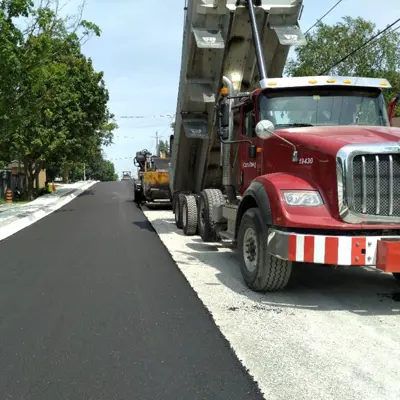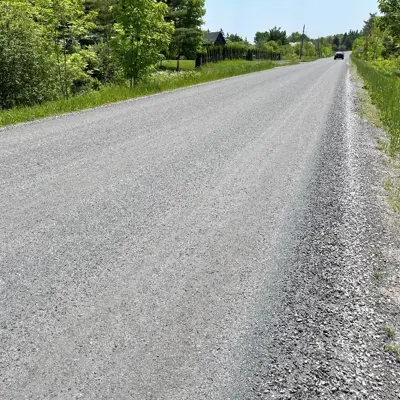Road Reconstruction and Preservation
Current Road Construction Projects
Municipal Capital Infrastructure Projects
Infrastructure projects are informed by the Township’s State of the Infrastructure asset management report, Active Transportation and Transportation Master Plan, and Development. Project cycles may include environmental assessment studies, detailed design, public consultation, and construction.

Road Reconstruction
Road reconstruction in rural areas involves removing and replacing the asphalt and granular base and may include ditching and culvert replacements and upgrades.
For urban areas, this may include the installation of curbs, storm sewers, watermain, sanitary sewers, and sidewalks.
Temporary or full road closures are usually required for the duration of these projects which are usually completed within a single construction season.

Road Rehabilitation
Road rehabilitation typically involves milling or pulverizing asphalt and replacing it with new hot-mix asphalt. The depth of asphalt removed depends on the condition of the road and depth of the existing asphalt. Rehabilitation may include repairs to existing curbs and sidewalks. Rehabilitation addresses problems on the roadway surface by replacing all or part of the top layer of asphalt pavement. It addresses issues like potholes, cracking, hummocks, bumps, and patches.
This work can usually be completed within a few days and is substantially less expensive than full road reconstruction.

Double High Float Surface Treatment
Double high float surface treatment involves several steps. The first step is pulverizing the existing hard surface treatment. The second step includes the addition of granular and base stabilization. Third is applying an asphalt emulsion and placing and packing a layer of aggregate material. This process is repeated with another layer of asphalt emulsion topped with aggregate. Finally, a bonding coat is applied to lock in the loose aggregate.
This type of treatment is only used on rural roads. Work can usually be completed within a couple weeks and is substantially less expensive than full road reconstruction or asphalt paving.
Preservation Treatments
Pavement preservation treatments typically involve application of thin, bituminous-based products to existing pavement. They differ from the other construction methods because they:
- do not involve the removal of existing surface material.
- are less costly.
- are applied earlier in the pavement life.
- can be applied quickly, minimizing disruption.
Pavement preservation activities are often equated to fixing the roof on your house. Replacing the shingles at regular intervals prevents water from getting into the house structure, which could cause expensive structural damage. Appropriately timed preventative maintenance in roads keeps water out of the pavement layers preventing cracks and defects from forming.

Single Surface Treatment
Single Surface Treatment is performed on Double High Float treated roads that are beginning to show signs of distress but are otherwise performing well. The existing road is swept and then sprayed with an asphalt emulsion and a single layer of aggregate material. This is followed by a bonding coat to lock in the loose aggregate.
The Township applies Slurry Seal to their surface treated roads within a few months of completion to extend their life and provide a smooth and quiet road surface.

Reclamite®
Reclamite® is a maltene based asphalt rejuvenator that improves asphalt performance. Reclamite® is applied to asphalt roads to extend their life by 5-7 years. It is especially good to reduce cracking caused by the freeze thaw cycle. The maltene fractions penetrate the surface of asphalt and improves the flexibility of the pavement. Reclamite® is best for pavements with early signs of aging (minor cracking, raveling, and pitting). It can also be applied to newer pavements as it tightens and seals the surface to preserve the original, new condition.

Gravel Resurfacing
Gravel resurfacing involves placing a fresh layer of Granular A on top of existing gravel roads. The new gravel is then graded to provide an even layer and slope the surface to drain to the ditches. Finally, a layer of dust suppressant is applied to firm up the surface and reduce dust.

Crack Sealing
Crack sealing involves the routing and sealing of cracks in asphalt road surfaces. The process begins with routing the cracks to remove debris and making them wide enough for the sealing compound. Then the crack is sealed, and a protective coating is applied to protect the sealing compound as it cures.

Slurry Seal
Slurry seal involves applying an asphalt emulation (liquid asphalt) combined with fine crushed aggregate on top of an existing road surface. Slurry Seal is best used on top of surface treated or asphalt roads. It is common to apply slurry seal following the double high float surface treatment.

End of Life Holding Strategies
In contrast with the methods outlined for preservation, the End of Life Holding Strategies are a reactive technique. Roads within the Township that have failed and are not delivering the expected or desired level of service but are not planned to be reconstructed in the short term are good candidates for this method. A holding strategy is a relatively minor investment to achieve a short-term service improvement until more permanent improvements are made. Candidate roads would be those where reactive maintenance activities, like pothole filling are very common. Examples of a holding strategy method would be large scale patching or overlaying of material over a particularly bad area.
Contact Us
Public Works and Infrastructure Services
181 Perry Street | Port Perry, ON
905-985-7346 x 112 | F: 905-985-9914
